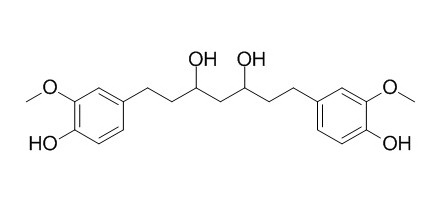Octahydrocurcumin
Octahydrocurcumin has antioxidant and and anti-inflammatory activities, it can inhibit the lipopolysaccharide (LPS)-induced inflammatory response via the mechanism of inhibiting NF-κB translocation to the nucleus. Octahydrocurcumin exhibits potent cytotoxic effect (IC50 =19.46 ug/mL) and shows high antimicrobial activity.
Inquire / Order:
manager@chemfaces.com
Technical Inquiries:
service@chemfaces.com
Tel:
+86-27-84237783
Fax:
+86-27-84254680
Address:
1 Building, No. 83, CheCheng Rd., Wuhan Economic and Technological Development Zone, Wuhan, Hubei 430056, PRC
Providing storage is as stated on the product vial and the vial is kept tightly sealed, the product can be stored for up to
24 months(2-8C).
Wherever possible, you should prepare and use solutions on the same day. However, if you need to make up stock solutions in advance, we recommend that you store the solution as aliquots in tightly sealed vials at -20C. Generally, these will be useable for up to two weeks. Before use, and prior to opening the vial we recommend that you allow your product to equilibrate to room temperature for at least 1 hour.
Need more advice on solubility, usage and handling? Please email to: service@chemfaces.com
The packaging of the product may have turned upside down during transportation, resulting in the natural compounds adhering to the neck or cap of the vial. take the vial out of its packaging and gently shake to let the compounds fall to the bottom of the vial. for liquid products, centrifuge at 200-500 RPM to gather the liquid at the bottom of the vial. try to avoid loss or contamination during handling.
Molecules.2019, 24(10):E1926
Phytother Res.2018, 32(12):2551-2559
JLiquid Chromatography & Related Tech.2021, 10826076.
Revista Brasileira de Farmacognosia2024, 34:1276-1286.
RSC Adv.2023, 13(9):6317-6326.
J Nat Med.2017, 71(4):745-756
J Cell Physiol.2021, 236(3):1950-1966.
Front Microbiol.2019, 10:2806
iScience.2023, 26(9):107602.
Molecules.2020, 25(21):5087.
Related and Featured Products
Pharmaceutical Research,2008, 25,(8):1822-7.
Different Curcuminoids Inhibit T-Lymphocyte Proliferation Independently of Their Radical Scavenging Activities[Reference:
WebLink]
We investigated the inhibitory effects of curcumin, curcumin derivatives and degradation products on OKT3-induced human peripheral blood mononuclear cell (PBMC) proliferation and the role of their radical scavenging activity.
METHODS AND RESULTS:
OKT3-induced human PBMC proliferation was determined by measuring 3H-thymidine incorporation. Radical scavenging activity was evaluated by using an in vitro DPPH assay.
OKT3-induced PBMC proliferation was inhibited by curcumin, isocurcumin, bisdesmethoxy-, diacetyl-, tetrahydro-, hexahydro-, and Octahydrocurcumin as well as by vanillin, ferulic acid, and dihydroferulic acid with IC50-values of 2.8, 2.8, 6.4, 1.0, 25, 38, 82, 729, 457, and >1,000 μM, respectively. The investigated substances with the strongest effect on radical scavenging were tetrahydro-, hexahydro-, and Octahydrocurcumin with IC50 values of 10.0, 11.7, and 12.3 μM, respectively. IC50-values of dihydroferulic acid, ferulic acid, and curcumin were 19.5, 37, and 40 μM. The substances with the lowest radical scavenging activities were vanillin, isocurcumin, diacetylcurcumin, and bisdesmethoxycurcumin with IC50 values higher than 100 μM each.
CONCLUSIONS:
Curcuminoid-induced inhibition of OKT3-induced PBMC proliferation depends on the number of carbon atoms and double bonds of the 1,6-heptadiene-3,5-dione structure as well as on the phenolic ring substitutes of the curcuminoids but is not correlated to their respective radical scavenging activity.
Biol.Pharm. Bull., 2007, 30(1):74-8.
Comparative antioxidant activities of curcumin and its demethoxy and hydrogenated derivatives.[Pubmed:
17202663]
METHODS AND RESULTS:
The antioxidant activities of curcumin, its natural demethoxy derivatives (demethoxycurcumin, Dmc and bisdemethoxycurcumin, Bdmc) and metabolite hydrogenated derivatives (tetrahydrocurcumin, THC; hexahydrocurcumin, HHC; Octahydrocurcumin; OHC) were comparatively studied using 2,2-diphenyl-1-picrylhydrazyl (DDPH) radical, 2,2'-azobis(2-amidinopropane)dihydrochloride (AAPH) induced linoleic oxidation and AAPH induced red blood cell hemolysis assays. Hydrogenated derivatives of curcumin exhibited stronger DPPH scavenging activity compared to curcumin and a reference antioxidant, trolox. The scavenging activity significantly decreased in the order THC>HHC=OHC>trolox>curcumin>Dmc>>>Bdmc. Stronger antioxidant activities toward lipid peroxidation and red blood cell hemolysis were also demonstrated in the hydrogenated derivatives. By the model of AAPH induced linoleic oxidation, the stoichiometric number of peroxyl radical that can be trapped per molecule (n) of hydrogenated derivatives were 3.4, 3.8 and 3.1 for THC, HHC and OHC, respectively. The number (n) of curcumin and Dmc were 2.7 and 2.0, respectively, which are comparable to trolox, while it was 1.4 for Bdmc. The inhibition of AAPH induced red blood cell hemolysis significantly decreased in the order OHC>THC=HHC>trolox>curcumin=Dmc.
CONCLUSIONS:
Results in all models demonstrated the lower antioxidant activity of the demethoxy derivatives, suggesting the ortho-methoxyphenolic groups of curcumin are involved in antioxidant activities. On the other hand, hydrogenation at conjugated double bonds of the central seven carbon chain and beta diketone of curcumin to THC, HHC and OHC remarkably enhance antioxidant activity.
Mol Med Rep . 2015 Apr;11(4):3087-93.
Curcumin and its major metabolites inhibit the inflammatory response induced by lipopolysaccharide: translocation of nuclear factor-κB as potential target[Pubmed:
25502175]
Abstract
The aim of the present study was to investigate and compare the anti‑inflammatory activities of curcumin and its three metabolites, tetrahydrocurcumin, hexahydrocurcumin and Octahydrocurcumin in lipopolysaccharide (LPS)‑stimulated RAW 264.7 macrophage cells. The results demonstrated that overproduction of nitric oxide (NO) was potently inhibited following treatment with curcumin and its three metabolites. In addition, curcumin and tetrahydrocurcumin significantly inhibited the release of prominent cytokines, including tumor necrosis factor‑α (TNF‑α) and interleukin‑6 (IL‑6); however, hexahydrocurcumin and Octahydrocurcumin did not significantly alter cytokine release. Furthermore, the present study investigated the effect of curcumin and its metabolites on the expression of inducible NO synthase (iNOS), cyclooxygenase‑2 (COX‑2) and activated‑nuclear factor kappa B (NF‑κB); the results showed that curcumin and its three metabolites significantly inhibited LPS‑mediated upregulation of iNOS and COX‑2 as well as NF‑κB activation. However, curcumin exerted a more potent effect on LPS‑stimulated RAW 264.7 cells compared to that of its three metabolites, of which tetrahydrocurcuim was found to be the most pharmacologically active. In conclusion, the results of the present study demonstrated that curcumin and its major metabolites inhibited the LPS‑induced inflammatory response via the mechanism of inhibiting NF‑κB translocation to the nucleus.



